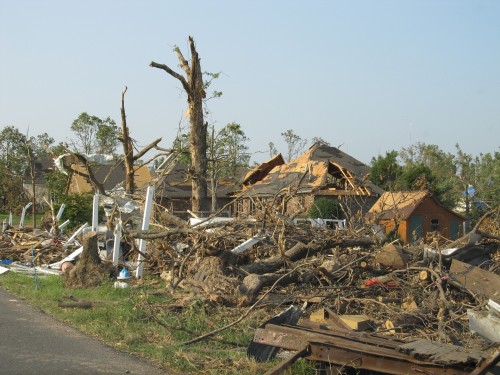Tornadoes can form suddenly with little warning and cause huge amounts of damage to both property and people. In 2011, a multi-vortex EF5 tornado struck Joplin, Missouri. It killed 161 people and caused $3.12 billion in property damage, making it the costliest tornado in recent history. In Bangladesh in 1989, the Daulatpur-Saturia tornado killed about 1,300 people, making it the deadliest tornado in the world. There are about a thousand tornadoes a year in the US alone and even though most don’t cause the same amount of death and destruction that the Joplin and Daulatpur-Saturia tornadoes did, they are still incredibly dangerous.
But what can you do to protect your organization from a tornado? While there may not be much you can do to prevent damage to property if a tornado comes through your location, there are steps you can take to help protect the people who may be on site. Your organization should have an emergency communication system, like the MessageNet system, that should already have features you can use to save lives in the event of a tornado.
Hold Regular Tornado Drills
The best thing you can do to ensure the safety of everyone at your organization is to hold regular tornado drills. Even if everyone at your organization is familiar with the proper procedures, it helps to actually experience as closely as possible what an actual tornado would be like, including where they’ll need to go and what messages they will receive in warning. An emergency situation of any kind can cause people to panic, so it’s important to have rehearsed exactly what to do should a tornado actually strike. It’s not enough to have a plan if your staff might not remember what they need to do during an actual emergency. Fortunately, you should be able to use your emergency communication system to create and schedule tornado drills.
Create a Tornado Drill Message
The tornado drill message should behave the same way as an actual tornado warning message. If your tornado warning message sends an email, texts cell phones, makes phone calls, and displays on LED and LCD signs, then your tornado drill message should as well. Everyone should know that it’s a drill, either because they were informed ahead of time or because the word drill is built into the text off the message. If you prefer ad-hoc tornado drills, then the message will need to be manually launched. Otherwise, you can schedule it to launch at a specific time and date.
Designate Tornado Shelters Ahead of Time
It’s important that anyone within your organization knows ahead of time exactly where they should go in the event of a tornado. You can use your emergency communication system to send different messages to different people and via different mediums. A general tornado warning message can be sent to email and cell phones because you don’t know where people will be when they receive emails or texts. You can send location-specific messages indicating where the nearest sheltered location is to more permanent devices, such as computers, LED signs, LCD screens, and PA devices.
Display Maps with Routes to Safe Locations
You can used devices like MessageNet’s Omni and MediaPort to display images like maps on your LCD screens. This is useful for emergency messaging because you can display a map on LCD screens with that is appropriate to each building. If you can provide maps with routes indicated on them, then different devices even within the same building can have the most appropriate maps displayed.
Save Tornado Emergency Messages Ahead of Time
Many systems, MessageNet included, allow you to compose ad-hoc messages that you can then send immediately. However, when it comes to your emergency messages, it can save vital time during an emergency situation to have your messages saved ahead of time. Sometimes, there are details you need to add that can only be done on an ad-hoc basis and that can be added later. However, a pre-saved tornado message can be launched much more quickly and will allow your staff to get to a shelter more quickly.
Create Messages for Both Public and Private Devices
Different types of devices need to receive different types of communication in an emergency situation. For example, public devices that stay in one location, such as LCD screens and LED signs, can receive location-specific messages. These can even direct people to the right location for a tornado shelter. Messages displayed on public devices like signs will also need to be information that is appropriate for everyone to receive. Information sent to private devices such as email and cell phones shouldn’t receive location-specific information because you won’t necessarily know ahead of time where the recipients will be at any given time. However, private devices can receive messages that are specific to people within different departments. For example, members of the security team might need different information than administrators or IT personnel in an emergency.
Have a Plan for After the Tornado
No matter how much you prepare for a tornado, there’s no avoiding the damage they can cause. You can use your emergency communication system to help prepare your staff for what to do after a tornado has occurred. So long as your emergency communication system is still functional in the aftermath, you can use it to keep people informed about whether it’s safe to be in certain parts of the building and what precautions they can take to stay safe.

